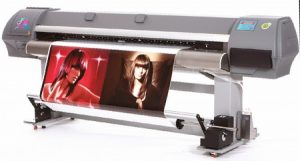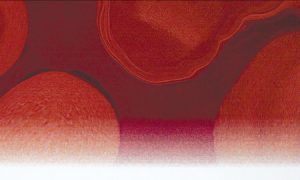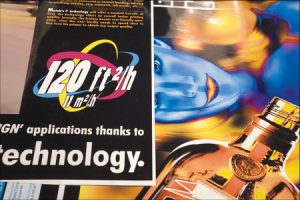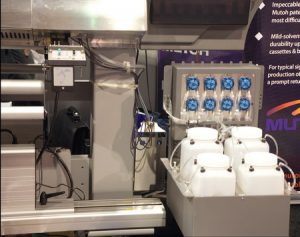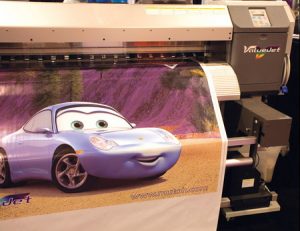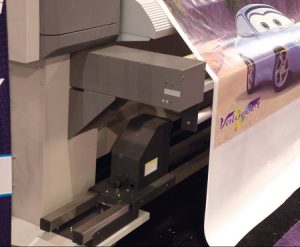Each year, Mutoh America seemingly introduces something new. The company has been at the digital-printing forefront, not only with some of the best-featured printers, but with prices in line with signmakers’ budgets. Well, Mutoh has – in our option – successfully tackled one of digital printing’s most vexing problems.
No, we’re not talking about one-cent-per-sq.-ft. ink pricing but, rather, the horrible artifact of banding. Banding manifests itself as visible, usually horizontal lines (sometimes vertical though) that stretch across the image. Usually clogged or dead nozzles are the culprit.
Paper movement and heavily saturated images can produce banding as well. If you don’t check your images frequently, you could face a costly redo.
Mutoh uniquely addressed this problem and, interestingly, has added printer speed. We’ll explain the new Intelligent Interweaving (I2 or I Squared) technology and the printers that utilize it.
Stop banding?
First, nothing truly eliminates potential banding. A damaged head or mismatched media can still produce banding, even on an I2 printer. That said, let’s see what Mutoh is doing differently.
A digital printer’s printheads apply ink in a series fashion during the print process. As the process progresses, colors build up – from light (the initial application) to full color, as they combine on the media. Generally, print machines apply the ink in a straight-line fashion, even if the RIP has programmed a stochastic or another error-diffusion pattern. If the profile is correct, the ink and media match and the media-advance system works properly, you get smooth, clean and band-free images. If any one thing falters, you have a problem.
Advertisement
Mutoh decided this problem could be attacked scientifically. We won’t bore you with the science; in fact, it’s magic to us anyway. In essence, Mutoh has chosen a “wavy” interlacing pattern (Fig. 1), as opposed to the traditional, horizontal pattern.
In addition, the company refined its precise, ink-drop sizes and ink volume. This sped up the print process. Banding occurs more frequently in bi-directional mode. So, to attain a printer’s best image quality, use a single-pass mode where the heads only print in one direction.
The I2 technology – unaffected by printing direction – runs in a bi-directional mode. So the net is a real win-win for the signmaker. You can now own a solvent-ink printer that can produce giclee-quality images with up to a 40% speed increase.
Did we mention printer maintenance became easier as well?
No, you can’t just forget about cleaning, and proper media alignment and loading, but the pain of “tuning” a printer after having changed a roll of media is greatly eliminated. We can honestly say Mutoh prints were clean, with no visible banding; the blacks were very dark, and bright colors were very saturated and vibrant. Mutoh introduced some new printers and upgraded a few others that utilize the I2 technology. Next, we’ll look at these printers.
Advertisement
The Spitfire Extreme
Mutoh’s Spitfires fall into the mid-range category – designed for medium to large shops that produce outdoor images on off-the-shelf adhesive vinyl. The printers’ I2 technology decreases down time for maintenance and re-prints, and speed keys their success. Mutoh offers two Spitfire models. The Spitfire 65 handles media up to 65 in. wide, the Spitfire 90, up to 90 in. wide. The printable image width measures 64.6 in. and 88.18 in., respectively.
The printers’ new piezo-printhead design comprises 360 nozzles per color. The print resolutions are 360 x 360 dpi, 720 x 360 dpi, 540 x 720 dpi and 720 x 720 dpi. Not quite fine-arts category, but these resolutions create photographic like images (Fig. 2).
Mutoh claims the 540 x 720-dpi mode is a good compromise between quality and performance. At this setting, the machine can print 177.6 sq. ft. per hour. In sign mode – where the image quality isn’t as important – the printer can rock at 376.7 sq. ft. per hour.
A Spitfire contains eight color channels, but if it’s set up for higher print quality, it’ll run as a CMYKLcLm. Also, the extra channels can be used for pure speed, in which case you’ll run a dual CMYK configuration.
The printers use either 220- or 440ml ink cartridges. An optional kit allows a bulk-ink system that will handle 4.3-liter bottles (Fig. 3). The mild-solvent inks are for rigorous, outdoor use. Typical signs require no lamination and can last up to three years outdoors.
Advertisement
A heavy-duty, media-handling system can support up to 220-lb. media rolls. A four-stage heating system insures the prints are virtually dry after imaging. The Spitfire Extreme 65 costs approximately $30,000, and the 90 at $36,995.
The ValueJet Family
The Spitfire Extreme family might be too expensive for small and some medium-sized signshops. Mutoh’s ValueJet printers, however, really live up to their name. These printers aren’t new, but numerous enhancements, such as a new printhead, the X-rail design and, of course, I2 technology, have re-born these printers.
Three products comprise the ValueJet family. The baby, the 1204, supports media up to 51.2 in. wide, with a 48-in. printable area. The middle child, the 1604, jumps up to 64 in., with a 63.3-in. printable area. Finally, the big brother, the 2606, supports media up to 102.4 in., with a 102-in. printing area.
These printers all have the same piezo, drop-on-demand printhead. The 1204 and 1604 contain one head; that’s 180 nozzles x eight lines. The 2606 comprises six heads that are 180 nozzles x two lines. Print modes range from draft, high-speed printing, all the way up to fine-art quality output (Fig. 4). The printers also use a similar, three-stage heating system that incorporates pre, platen and post heaters.
Each printer uses the Eco-Ultra inks that offer three-year outdoor image life with limited office venting. The 1204 and 1604 use a four-color (CMYK) system, while the 2606 uses six colors (CMYKLcLm). The 1604 and 2606 use 220 or 440ml ink cartridges. Because of the 1204’s design, Mutoh recommends using only the 220s.
The 1604 comes with a standard, 3-in.-core, take-up system. The 2606, on the other hand, carries a heavy-duty, take-up system (Fig. 5), which can handle up to 220-lb. media rolls.
For the printing-production mode. The 1204 runs at 140 sq. ft. per hour. Interestingly, the original ValueJet was rated at 100 sq. ft. per hour. This represents a 40% increase in speed. The 1604 prints slightly faster at 145 sq. ft. per hour. Finally, the 2606, with its six heads, can print at 185 sq. ft. per hour. Slower than the Spitfire Extreme printers, these speeds are still very respectable.
The entry-level ValueJet 1204 costs approximately $15,000. Mutoh also offers a special bundle price with an Ultima 1400 vinyl cutter for $21,995. For something wider, with a take-up system, the 1604 is listed at $21,995 to $28,995 with the Ultima cutter.
Mutoh has cut the price of its 102-in. ValueJet 2606 from last year’s price of $54,995 down to $44,995.
The 1204 and 1604 come bundled with Flexi-Print SE. The 2606 actually comes with Onyx’s RIP software.
Conclusion
Mutoh’s I2 technology seems to improve print quality by virtually eliminating banding. Mutoh introduced this technology in two printer families: one which caters to the small signshop that’s getting into digital printing; the other to medium-size to large shops that desire high-speed, low-maintenance solutions. Mutoh is clearly riding the wave.
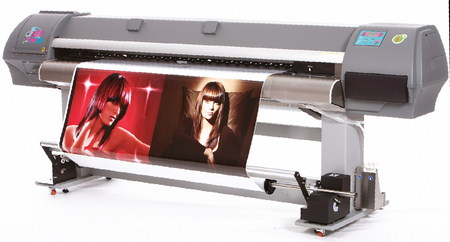


 Photo Gallery2 weeks ago
Photo Gallery2 weeks ago
 Ask Signs of the Times2 weeks ago
Ask Signs of the Times2 weeks ago
 Paula Fargo1 week ago
Paula Fargo1 week ago
 Real Deal5 days ago
Real Deal5 days ago
 Photo Gallery1 week ago
Photo Gallery1 week ago
 Women in Signs2 weeks ago
Women in Signs2 weeks ago
 Women in Signs2 weeks ago
Women in Signs2 weeks ago
 Projects5 days ago
Projects5 days ago